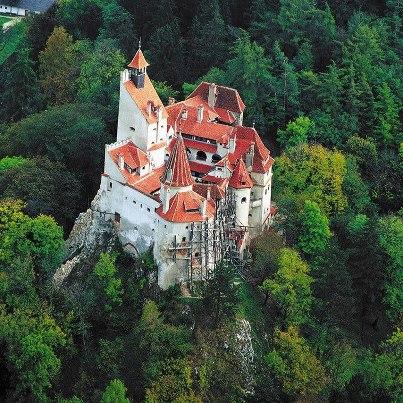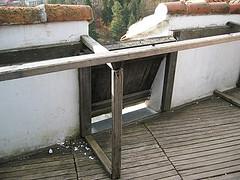

Location: Bran, Brașov County Map
Tel: (268) 238 332 (info)
Hours: Tue-Sun 9am - 5pm
Train: Brasov
Bus: Buses marked 'Bran-Moeciu' depart every half-hour from Brasov's Autogara 2
Entrance Fee: adult €3, children €1.5
Bran Castle, often dubbed "Dracula's Castle," is a striking medieval fortress perched on a rocky cliff in the village of Bran, approximately 25 kilometers southwest of Brașov in Transylvania, Romania. Situated at coordinates 45°30′54″N 25°22′02″E, this national monument and landmark overlooks the Bran Pass, a historic trade route connecting Transylvania and Wallachia. Built in the late 14th century, the castle blends Gothic and Renaissance architectural elements, rising dramatically with its red-tiled towers and white walls against the Carpathian Mountains. While famed for its loose association with Bram Stoker's Dracula and the historical figure Vlad the Impaler, it primarily served as a defensive stronghold, customs point, and royal residence. Today, it functions as a museum attracting over 1 million visitors annually, offering insights into Romanian history, medieval life, and folklore. Recognized for its cultural significance, Bran Castle captivates with its eerie legends, preserved interiors, and panoramic views, making it one of Romania's top tourist destinations.
The history of Bran Castle dates back to the 13th century, with the
first documented mention of a wooden fortress on the site in 1212, built
by the Teutonic Knights to defend against invasions. This early
structure was destroyed by the Mongols in 1242. The current stone castle
was constructed in 1377 by Transylvanian Saxons under the privilege
granted by King Louis I of Hungary, who allowed them to build a fortress
in exchange for defending the border. Completed in 1388, it served as a
strategic military outpost and customs house, controlling trade through
the pass.
In the 15th century, the castle briefly came under the
control of Wallachian voivode Mircea the Elder, and later Vlad the
Impaler (Vlad III Dracula) used it as a base during his campaigns
against the Ottomans in 1459-1462, though he never resided there
long-term. By the 16th century, it fell under Habsburg rule, and in the
18th century, it was part of the Austrian Empire's border defenses.
After World War I, following the unification of Romania, the castle was
gifted to Queen Marie of Romania in 1920 by the people of Brașov as a
token of appreciation for her role in the union. Queen Marie renovated
it extensively, turning it into a royal summer residence with modern
amenities while preserving its medieval charm. Upon her death in 1938,
it passed to her daughter, Princess Ileana.
During World War II,
Princess Ileana used the castle as a hospital for wounded soldiers. In
1948, under communist rule, the royal family was expelled, and the
castle was nationalized, serving as a museum from 1956 onward. In 2009,
ownership was restored to Archduke Dominic Habsburg, Princess Ileana's
son, who sold it to a private company but continues to manage it as a
museum. Today, it remains a symbol of Transylvanian heritage, with
ongoing preservation efforts to maintain its historical integrity.

Porthole for poring hot oil.
Bran Castle's architecture is a fusion of Gothic, Renaissance, and
Baroque styles, reflecting its evolution over centuries. Built on a
60-meter-high cliff, the irregular polygonal structure features four
towers, narrow winding staircases, and secret passages designed for
defense. The exterior showcases white plastered walls, red-tiled roofs,
and timber-framed elements, with battlements and arrow slits emphasizing
its fortress origins. The castle spans 57 rooms across multiple levels,
connected by a labyrinth of corridors and stairs.
Key architectural
features include the inner courtyard with a 57-meter-deep well
(legendarily hiding a secret passage), the Gothic chapel added in the
15th century, and Queen Marie's additions like electricity, elevators,
and Art Nouveau furnishings. The entrance tower, the tallest at 23
meters, offers commanding views, while underground chambers and a secret
staircase within the walls add to its mysterious allure. Renovations in
the 1920s-1930s introduced modern comforts without compromising the
medieval aesthetic, blending historical authenticity with royal
elegance.
Bran Castle's global fame stems from its association with Bram
Stoker's 1897 novel "Dracula," where the fictional Count Dracula's
castle is described in ways resembling Bran's dramatic setting. However,
this link is largely mythical; Stoker never visited Romania and likely
drew inspiration from illustrations and descriptions of Bran. The real
historical tie is to Vlad III Dracula (Vlad the Impaler), the
15th-century Wallachian prince known for his brutal tactics against
enemies, including impalement. Vlad used the castle briefly during
military campaigns but was imprisoned elsewhere, not at Bran.
Romanian folklore adds layers with tales of strigoi (vampire-like
creatures), though these predate Stoker's work and aren't directly tied
to the castle. The "Dracula" branding emerged in the 1970s through
tourism promotion, capitalizing on the castle's gothic atmosphere.
Today, exhibits debunk myths while embracing the legend, featuring
vampire lore and Vlad's history to educate visitors on fact versus
fiction.
As a museum since 1956, Bran Castle houses collections focused on
medieval art, royal history, and ethnography. Highlights include Queen
Marie's apartments with antique furniture, tapestries, and personal
artifacts; the medieval armory displaying weapons and armor; and the
Time Tunnel, an elevator ride through the castle's history with
multimedia effects. The torture chamber exhibits gruesome instruments,
tying into Vlad's reputation.
Other attractions: The secret staircase
leading to the library, panoramic terraces overlooking the Moeciu
Valley, and the surrounding park with a tea house built by Queen Marie.
Special exhibits on Dracula lore include replicas of vampire-hunting
kits and historical documents. Events like Halloween nights and medieval
festivals enhance the experience. Nearby, the Bran Village Museum
showcases traditional Romanian peasant life.
Bran Castle is open year-round, with hours varying by season: 9 AM-6
PM (Tuesday-Sunday) from April to September, and 9 AM-4 PM in winter
(closed Mondays except summer). Admission is about 45 RON (≈€9) for
adults, with discounts for students and seniors; audio guides and guided
tours available for extra fees. The Time Tunnel costs an additional 20
RON. Access is via a steep 10-15 minute uphill walk from the parking
lot; wear comfortable shoes. Crowds peak in summer and around Halloween;
visit early or off-season for a quieter experience.
Parking is
available nearby (10 RON/hour), and public buses run from Brașov.
Facilities include a gift shop selling Dracula souvenirs, a restaurant,
and restrooms. Photography is allowed without flash; no drones. For an
in-depth visit, allocate 1-2 hours; combine with nearby sites like
Râșnov Fortress or Poiana Brașov. Official website: www.bran-castle.com
for tickets and updates.